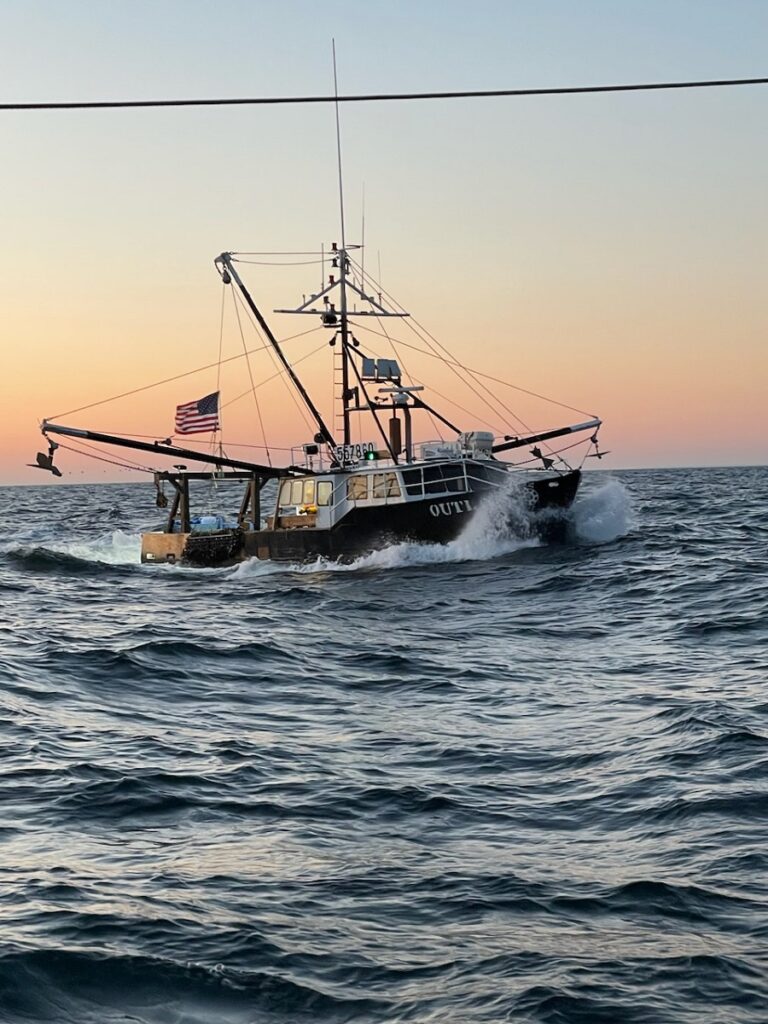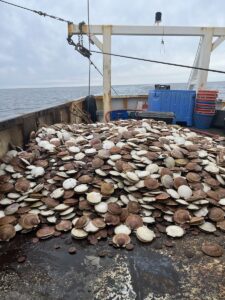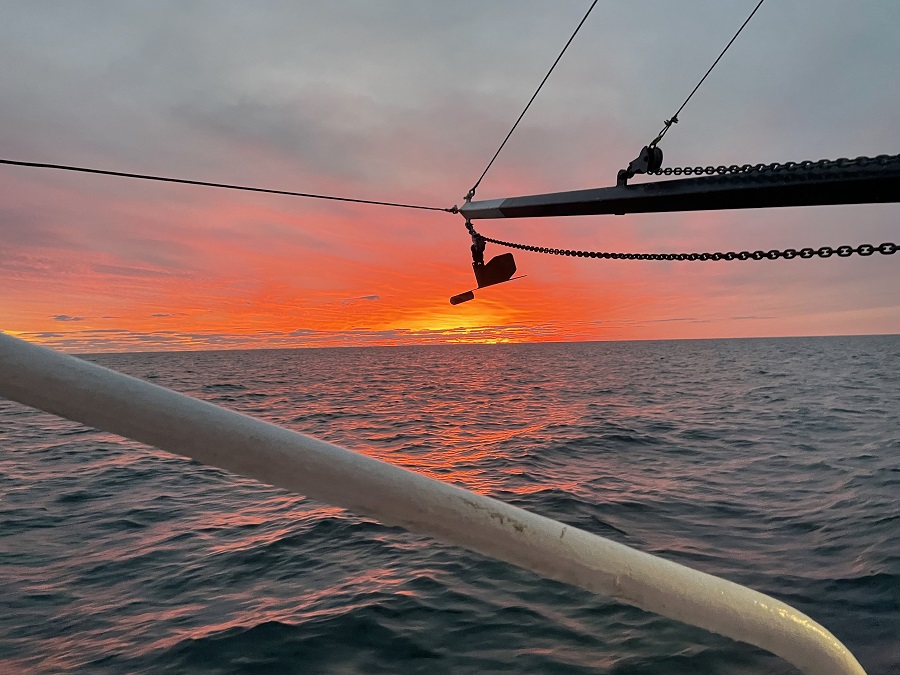This article was updated on August 4, 2023.
PROVINCETOWN — A decline in scallop stocks combined inexplicably with low wholesale prices have made this a tough year for small-boat scallop fishermen. But what Outer Cape scallopers say they’re most worried about is how these conditions exacerbate a bigger problem: the quota system that regulates the small-boat fleet.
Every year, regulators set a maximum number of pounds of scallops the entire small-boat fleet is allowed to catch. Each vessel owns or leases a share of that total, which determines how many pounds of scallops it can land that year. That share is called quota. Owning or leasing one percent in quota, for example, allows a vessel to take one percent of the total regulators set.
Each vessel must first purchase a permit — there are about 300 available for small-boat scalloping — before leasing or buying quota to attach to it. The permits and quota are generally bought and sold through marine brokerage firms.

Scallopers say the major flaw in this so-called catch-share system, which is also used in a handful of other federal fisheries, is that it requires them to pay huge fees every year to lease quota. It’s an expensive extra cost, they argue, that makes it especially hard to get into the business.
“It’s a failed system,” said Damian Parkington of Wellfleet, owner of the F/V Roen Keil, “and it’s done a number on small business in coastal communities.”
Others argue that the quota system is imperfect but there’s no better way to divide the limited fishery resource fairly and sustainably.
“What’s the alternative?” asked Paul Parker, a partner at the Atlantic Brokerage House. Parker founded the Cape Cod Fisheries Trust, a nonprofit that has leased quota to Cape Cod fishermen at reduced rates since the catch-share system was implemented in 2008.
Most active scallopers own very little quota. According to National Marine Fisheries Service permit records, 36 percent of active vessels didn’t own any quota at the start of the fishing year, while 77 percent owned less than a 0.5-percent share of the small-boat fleet’s stocks. That means scallopers must lease most of the quota they use from other permit holders.
Leasing 2.5 percent — the maximum that any one vessel is allowed — can cost over $150,000 per year.
Those who own quota frequently aren’t active scallopers. Forty-nine percent of quota was attached to inactive permits not affiliated with a vessel. This quota is generally leased to active fishermen, with its owners sometimes referred to as “armchair fishermen” or “slipper skippers.”
“They’re at home making hundreds of thousands of dollars a year just for owning quota,” said Max Nolan, a scalloper from Eastham who owns the F/V Outlaw. “These guys aren’t fishing. They’re not putting in the work.”

The 11 scalloping permits with the most quota attached are all inactive. Three of those are owned by the nonprofit Fisheries Trust, but others are owned by investors. According to state LLC records, the permits with the fifth and the seventh most quota are both owned by the investment wing of Hartz Mountain Industries, a real estate company. Hartz owns 4.55 percent of the quota, worth around $2.6 million. Hartz executives did not respond to a request for comment.
According to Melanie Griffin of the New England Fisheries Management Council (NEFMC), the fishery’s chief regulator, it’s often difficult to determine who owns quota because most permits are attached to an LLC rather than an identifiable person.
Quota attached to inactive permits is often owned by retired fishermen, Parker said, but that practice is also controversial. Leasing out quota after retirement provides a lasting reward for the time scallopers spent in the fishery, Griffin said.
But that doesn’t sit well with active scallopers. “They don’t have anything to do with it anymore,” said James Gray of Wellfleet, owner of the F/V Bada Bing. “And here I am catching someone else’s quota.”
Another concern is the number of permits owned by non-scallopers. The cost of a permit, around $100,000, is a barrier to those looking to start scalloping on their own. Yet many permits sit unused by their owners. Many are part of permit “suites” — combinations of permits for different fish. NEFMC rules don’t allow individual permits in these suites to be sold separately, meaning that a scallop permit owned in a suite by someone who fishes for something else might go unused.
According to permit records and state LLC data, Blue Harvest Fisheries, a large seafood company, owns 14 small-boat scalloping permits. That is the most owned by any one business or individual that the Independent could verify. All Blue Harvest permits are inactive.
Blue Harvest’s foreign private-equity backing and dominance in the groundfish industry was the subject of a ProPublica investigation last year. That report prompted an initial U.S. Dept. of Justice inquiry into antitrust violations in the New England fishing industry.
Kelly Cardoso, a Blue Harvest executive, said that the company’s scalloping permits are part of suites that include permits for groundfish, the company’s focus. Blue Harvest has no plans to do anything with its scallop permits, she said.
It’s a problem that John Pappalardo, CEO of the Cape Cod Fisherman’s Alliance and a voting member on the NEFMC, said he will push the council to address by allowing suites to be split, opening up these permits to be sold to those who want to scallop.
With so much of the market controlled by non-scallopers, quota and permit ownership looks different from how it did when the system was adopted in 2008.
Previously, there had been no limits on the number of permits in the fishery and no shares of the scallop stocks. But after a spike in active vessels over the previous decade fueled concerns about overfishing, NEFMC sought to limit the number of fishery participants and the annual catch. The council adopted the quota system, using vessels’ catches from 2001 to 2004 to determine which boats would be issued permits and how much quota each would receive.
That left some people out, said Chris Merl, a Wellfleet scalloper who owns the F/V Isabel and Lilee. “There were a lot of people who lost their livelihood,” he said.

Many who were issued quota quickly sold it or began leasing it out, causing a further decline in fishermen — there were 592 active vessels in 2006 and 152 in 2010. But that is often the way catch-shares keep fisheries sustainable, said Chris Anderson, a fisheries economist at the University of Washington. And most agree the system has been successful in that sense.
“It’s a good fishery to be in because it’s very well managed,” Nolan said.
There are other advantages, scallopers admit. Parkington said it creates “bankability”: scallopers can use their permit and quota as collateral for a bank loan.
Additionally, because each fisherman acquires his own share of the fishing stocks, quota systems effectively reduce competition, Anderson said. “What’s really destructive to fishing businesses is when harvesters have to compete for fish.”
Still, some scallopers say a better way to prevent overfishing is to lower their catch limits per trip instead of forcing them to buy or lease the right to fish.
But Parker pointed to high permit prices in the lobster fishery, where quota doesn’t exist, as evidence that the market value of a permit would increase without the obligation to buy quota to attach to it.
If the quota system is here to stay, Nolan said, there should be some regulation to ensure scallopers can lease quota at fair prices. Griffin said that is outside the role of the NEFMC. “We’re not market regulators,” she said.
But Anderson said there are tools to reduce the share of the market controlled by non-fishermen. Other fisheries with catch-share systems have adopted rules requiring quota owners to be on the vessel while their quota is being fished, he said.
Another potential solution is the expansion of programs like the Fisheries Trust. “We’re seeing more cooperative systems where quota isn’t held by individuals but by cooperatives or groups that are working together to figure out who should fish, who should benefit,” Anderson said.
Still, the Fisheries Trust offers only a limited amount of reduced-rate quota, meaning Cape Cod scallopers must lease most on the open market. That makes being a small-boat scalloper on the Cape extremely expensive.
“I’m not going to lie — I’ve got a lot hanging over my head,” Gray said. “But I’ll make it. I’ll do something else if I have to.”
This is the third installment of a series on the small-boat fishing fleet of the Outer Cape. The first two parts appeared in the June 29 and July 20 issues.



